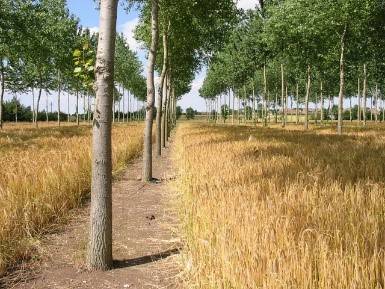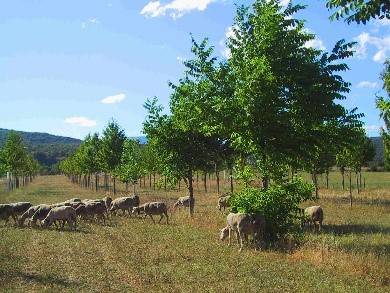Agroforestry
Associating trees and crops offers numerous benefits, and farmers are increasingly using wild trees on their farms.
What is agroforestry?
Agroforestry is “a dynamic, ecologically based natural resources management system that, through the integration of trees on farms and in the agricultural landscape, diversifies and sustains production for increased social, economic and environmental benefits for land users at all levels”*.
Associating trees, hedges and crops offers multiple benefits: soil protection and enhanced soil fertility, fewer inputs, improved natural biological control, improved plot microclimates, higher biomass production, carbon sequestration and diversified farm income.
*Definition by the World Agroforestry Centre

From past to present
Many ancient practices exist for associating trees, crops and livestock, such as meadow orchards which associate livestock and fruit production, or hedged farmlands which use hedgerows to provide firewood and tall standard tall trees to provide softwood lumber. Over the years, agricultural and forestry practices diverged as forests began to progress, and hedged farmlands declined. Trees were increasingly regarded as competition to crops due to land consolidation, mechanisation of farming practices and land artificialisation. Agricultural and forestry politics were constructed independently, leading to a policy of regional specialisation which now raises questions of economic and environmental performance.
Today’s agroforestry draws from traditional practices but has been adapted to modern day farming constraints: specific maintenance techniques, low tree density per hectare, trees aligned and chosen for their compatibility with crops (most often for food use) and their economic or environmental value. The key to agroforestry lies in effectively sharing resources between trees and associated crops, whose growth conditions are altered reciprocally. Farmers need to know how to promote positive interactions while limiting competition. Thanks to research efforts over the last 20 years, many innovative, productive and viable agroforestry initiatives can now be proposed.
Benefits of agroforestry
It has been shown that associating trees and crops is more productive than crop rotations separating crops on one side and trees on the other. The biomass production differential is 10-60%. A traditional agroforestry trial conducted by INRA, associating poplars with cereals, showed that a 100ha agroforestry farm produces as much biomass as a 140ha farm separating its crops*. Consequently, agroforestry contributes efficiently to carbon sequestration, through long-term plant biomass and soil, and through the incorporation of organic matter via litter or fine root renewal. Storage values recorded 0.3t of CO2eq/ha/year in intra-parcel agroforestry, and more than 1t of CO2eq/ha/year for certain groves**.
The viability of agroforestry cultivation systems depends on the biological efficiency of the association. Lower intercrop yield is compensated by the product produced long-term through tree sales, provided the unit value of wood is high. If alleys are twice as large than the height of adult trees, it is possible to farm until the trees are cut down, with tree-related income representing 30-50% of total net income.
Agroforestry promotes deeper rooting of trees than in forests. This enables trees to reach a better water supply and avoid water stress, and to recover subsoil nutrients from deep bedrock or leaching. The absence of competition between trees also improves tree diameter growth and therefore reduces the harvest age of trees. Moreover, trees can alter and diversify the microclimate around them (temperature, wind, humidity). This promotes pollinator habitats, and increases pollinator efficiency in case of pest or disease outbreaks.
*Dupraz C., Liagre F., 2008, Agroforesterie – Des arbres et des cultures. Éditions France Agricole, 410 p.
**Pellerin, S. et al. 2013. Quelle contribution de l’agriculture française à la réduction des émissions de gaz à effet de serre ? Potentiel d’atténuation et coût de dix actions techniques. Synthèse du rapport d’étude. 92 p. INRA.
Plan for the development of agroforestry
In December 2015, the Ministry of Agriculture launched a plan for the development of agroforestry, which is structured around national level politics and France’s international commitments, in particular in relation to the United Nations Framework Convention on Climate Change (UNFCCC). This plan aims to sustain and support the development of 200,000ha of hedgerows and 120,000ha of agroforestry by 2035. It is structured in 5 axis which break down the different actions for agroforestry, with a view to sustainably managing all forms of agroforestry, in all regions and all agricultural systems:
CTPS Forest Tree Section
Over the past few years, the CTPS Forest Tree technical section has incorporated agroforestry into its activities and objectives. Some of the forest tree varieties that are already registered have the potential for agroforestry production and are eligible for reforestation aid, in particular for poplar, walnut, chestnut and cherry trees. To meet requests for diversification of tree species, the CTPS Forest Tree section recently proposed to include three new species in the list of regulated forest species: hedge maple, alder, and wild apple. Moreover, the section contributes its expertise to a participatory breeding programme (co-constructed with farmers and nurseries) for tree varieties adapted to agroforestry systems which promote biodiversity, taking account of the particularities of woody species in developing technical regulations for registration.






